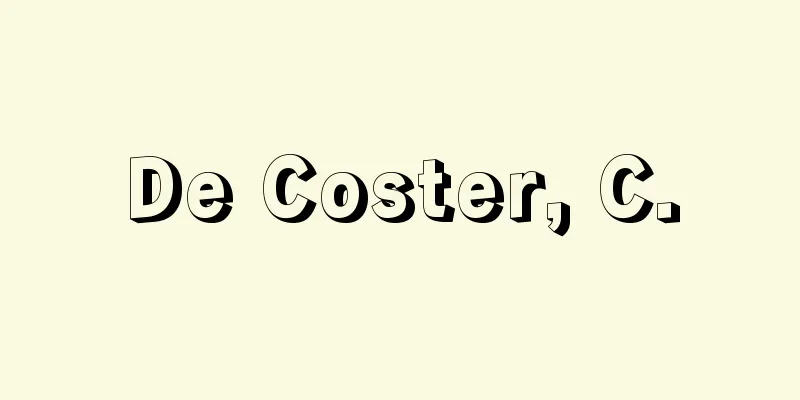Discovery - Discover

|
Discovery is a specialized term that is used in the usual sense of "finding something for the first time," and can be used to mean "geographical discoveries," "technical inventions," or "scientific discoveries" that are important in science and technology. Here, we will discuss the so-called "scientific discovery," which has been the subject of lively discussion in science theory and science history, especially since the 1960s. [Shinichi Miyashita] Kuhn and Hanson's heuristicsAmerican science historian T.S. Kuhn developed the so-called paradigm theory in his 1962 book The Structure of Scientific Revolutions. It was a kind of "scientific discovery theory" that regarded the "core" of a scientific revolution as a paradigm shift as a major discovery in the history of science, such as the discovery of X-rays or oxygen. Kuhn's "paradigm" is "a generally accepted scientific achievement that, for a certain period of time, provides experts with a model for how to ask questions and how to answer them," that is, a kind of intellectual framework (in the Koyré sense), but it also refers to a group of scientists who share the same paradigm, a "scientific community," and in that sense his discovery theory was also a sociological discovery theory. According to Kuhn, a scientific discovery, such as Roentgen's discovery of X-rays, is something that "happens to an individual in a specific time and space," that is, it is not a "single event." In other words, as is well known in the history of the discovery of X-rays, many scientists later claimed to have discovered X-rays themselves, due to unexplained fogging that occurred on photographic plates. Therefore, according to Kuhn, "if Roentgen's equipment produced X-rays, then many other experimentalists must have also been producing X-rays without realizing it," and therefore a discovery is nothing other than the simultaneous occurrence of many such chance discoveries (the "simultaneous discovery" theory, the "accidental discovery" theory). So, which of the many discoveries were true discoveries, and who among the group of scientists at the time (belonging to the old paradigm) was honored as the discoverer? In the case of X-rays, he considered that "notice of the anomaly that unexpectedly began to glow on the screen" "played an essential role leading to innovation," and he generally depicted the structure of scientific discoveries in terms of sociological and anomie theory as a "paradigm shift" from the old paradigm to a new paradigm, as shown in . In addition, the American philosopher of science Norwood Russell Hanson (1924-1967) believed in his book Patterns of Scientific Discovery (1958) that "observation" and the "facts" that are the result of it presuppose the existence of certain scientific knowledge and theories ("theory-ladenness"), and developed a theory of discovery that sees "scientific discovery" as a transformation of the framework of such knowledge or theory -- a kind of "theory transformation." However, this "transformation" was essentially a psychological one (Gestalt), in which something appears different depending on what it is associated with ( ). [Shinichi Miyashita] Scientific Awareness and DiscoveriesThe theories of discovery of these so-called "new school of philosophy of science" are criticized as being not only popular but also agnostic in scientific discovery theory as a whole, and as irrational and anti-scientific. The extreme development of the theories mentioned above, such as the complete denial of the "uniqueness of time and place of discovery" and the "theoretical nature of reasoning" as "myths," seems to support the validity of this criticism. In the history of science, there are many simultaneous discovery situations, such as the discovery of the law of conservation of energy by Joule, Mayer, and Helmholtz, but these should be understood in relation to the development stage of science (theory) and the level of technology (especially experiments) at that time. Furthermore, although a discovery may contain an element of chance, especially at the starting point, in the stage of discovery as experience, a true scientific discovery must be understood as a process of transforming chance into necessity in the process of scientific cognition. Otherwise, for example, in the case of the discovery of X-rays, there would be no objective criteria to distinguish the true discovery of X-rays from the numerous "false discoveries" made later by people who claimed "priority" in discoveries, claiming that they had in fact discovered phenomena caused by X-rays before Roentgen (such as unexplained fogging on photographic plates), or from occult and fantastical predictions of unknown new radiation, such as the "black ray" in "spiritual science," which was popular in the fin de siècle atmosphere of the time. Furthermore, there are arguments that distinguish between "theoretical discoveries" and "experimental/observational discoveries" as the theory of scientific knowledge, and that, with regard to the latter, the existence of "exploratory" discoveries is noted, and that the distinction between them and "accidental" discoveries is relativity. However, as already mentioned, the relationship between chance and necessity in scientific discoveries is not essentially a matter of classifying "types of discoveries," but is a matter related to the process of cognition, that is, the historical process of scientific discoveries, from "discovery as experience" to the establishment of laws. There is also a recent argument (Alexander Kohn) that focuses on the difference between "discovery and chance," but, despite the relatively realistic treatment of many examples of discoveries, this is merely one form of the popular "accidental discovery theory," and, as mentioned above, scientific discoveries are not essentially a matter of "scientific luck" or misfortune. [Shinichi Miyashita] "The Structure of Scientific Revolutions, by T.S. Kuhn, translated by Nakayama Shigeru (1971, Misuzu Shobo)" ▽ "The Theory of Scientific Knowledge, by Iwasaki Masatane and Miyahara Shohei (1976, Otsuki Shoten)" ▽ "The Discovery of X-Rays and Experiments, Technology, and Society (1) - An Examination of the Scientific Discovery Theory of T. Kuhn and Others, by Miyashita Shinkichi" (Studies in the History of Science, Vol. 21, II, 1982)" ▽ "Patterns of Scientific Discovery, by N.R. Hanson, translated by Murakami Yoichiro (1986, Kodansha)" ▽ "The Luck of Science: A Scientific History of Discoveries and Opportunities, by Alexander Kohn, translated by Tanaka Yasuo (1990, Kousakusha)" ▽ "The Essential Tension in Scientific Revolutions: Collected Papers of Thomas Kuhn, by Thomas S. Kuhn, translated by Abiko Seiya and Sano Masahiro (1998, Misuzu Shobo)" ▽ "Beyond Modern Science" by Yoichiro Murakami (Kodansha Academic Library) [References] | |The diagram above is Kuhn's "paradigm shift." The diagram below is Hanson's theory of discovery as "theory transformation," which is a psychological thing, like how if you connect the diagram on the left with the diagram on the right, you see a bird, and if you connect the diagram on the left with the diagram on the bottom, you see a chamois. Note: The diagram below is from N.R. Hanson, translated by Murakami Yoichiro, "How Scientific Theories Are Born" (1971, Kodansha / revised version "Patterns of Scientific Discovery" 1986, Kodansha Academic Library). The original is (1958, Cambridge University Press) ©Shogakukan "> Kuhn and Hanson's discovery theory (diagram) Source: Shogakukan Encyclopedia Nipponica About Encyclopedia Nipponica Information | Legend |
|
発見には、通常用いられている「初めてみつけだす」という意味を特化したものとして、「地理上の発見」や「技術的発明」と並び科学・技術上重要な「科学上の発見」がある。ここでは、とくに1960年代以降、科学論、科学史上で活発な議論が行われてきた、いわゆる「科学的発見」scientific discoveryを扱う。 [宮下晋吉] クーン、ハンソンの発見論アメリカの科学史家T・S・クーンは、1962年の『科学革命の構造』でいわゆるパラダイム論を展開した。それは、パラダイム変換としての科学革命の「核心」をX線の発見や酸素の発見のような科学史上の大発見とみなす、一種の「科学的発見論」であった。ところで、クーンの「パラダイム」Paradigmとは、「一般に認められた科学業績で、一時期の間、専門家に対して問い方や答えのモデルを与えるもの」、つまり、ある種の知的枠組み(コイレ流の)であるが、一方、同じパラダイムを共有する科学者集団、「科学共同体」でもあり、その点で彼の発見論は社会学的発見論でもあった。 クーンによれば、たとえばレントゲンによるX線の発見のような科学的発見は、「特定の時間と空間で個人に起こる」もの、すなわち「単一なできごと」ではない。つまりX線発見史上周知のように、写真乾板に生じた原因不明のかぶりなどから、後年、実は自分もX線を発見していたと称する科学者が続出したが、それゆえに彼によれば「レントゲンの設備がX線を生んだのなら、多数の他の実験家たちも気づかずにX線をつくっていたに違いない」、したがって発見は、そのような多数の偶然的な発見の、いわば同時多発的できごとにほかならない(「同時発見」説、「偶然的発見」説)。では、多数の発見のなかでどれが真の発見であり、当時の科学者集団(旧パラダイムに属する)のなかでだれが発見者の栄誉に輝くかについて、彼は、レントゲンの場合「スクリーンが予想に反して光りだした異常性anomalyに気づいたこと」が「革新性に導く本質的な役割を果たした」とみなし、一般的に科学的発見の構図を、社会学的にはアノミー論的に、旧パラダイムから新パラダイムへの「パラダイム転換」としてのように描き出した。 また、アメリカの科学哲学者ハンソンNorwood Russel Hanson(1924―1967)は『科学的発見のパターン』(1958)で、「観察」とその結果である「事実」は科学上の一定の知識や理論の存在を前提とすると考え(「理論負荷性」)、「科学的発見」をそのような知識や理論の枠組みの変換――一種の「理論変換」としてとらえる発見論を展開したが、その場合の「変換」は本質上、関連させるものによって、異なるものに見えるというような(ゲシュタルト)心理学的なものであった()。 [宮下晋吉] 科学的認識と発見これらのいわゆる「新科学哲学派」の発見論に対し、「同時発見」説、「偶然的発見」説は俗説であるばかりか、全体として科学的発見論における不可知論であり、非合理主義的・反科学的主張であるという批判がある。前述の発見論のその後の極端な展開、たとえば「発見の時間と場所の単一性」や「理由づけの理論的な本性」を「神話」として全面否定するような議論などは、その批判が当を得ていることを裏づけているように思われる。ジュール、マイヤー、およびヘルムホルツらによるエネルギー保存則の発見の例のように、科学史上、同時発見的状況は一般的に存在するが、それは、当時の科学(理論)の発展段階と技術水準(とくに実験)との関連で理解されるべきである。また発見には、とくにその出発点では、経験としての発見の段階で偶然的要素が含まれうるが、真の科学的発見とは、科学的認識のプロセスにおいて偶然を必然に転化させる過程と解する必要がある。さもなくば、たとえばX線発見の場合、あとになって実は自分はレントゲン以前にX線に起因する現象(写真乾板に生じた原因不明のかぶりなど)をみいだしていたとして、発見の「先取権」を主張した多数の「えせ発見」や、あるいは当時の世紀末的世情の下で流行していた「心霊科学」における「黒色光線」などオカルト的・空想的な未知の新放射線の予想と、真のX線発見を区別する客観的な基準はなにひとつ存在しなくなるからである。 さらにまた、科学的認識の理論として「理論的発見」と「実験・観察的発見」を区別したうえで、後者に関し「探検」的発見の存在に注意し、それと「偶発」的発見の間の区別の相対性を指摘する議論もあるが、科学的発見における偶然と必然の間の関係は、本質上「発見の諸タイプ」の分類の問題ではなく、認識のプロセス、すなわち「経験としての発見」から法則性の確立へ、という科学的発見の歴史過程にかかわる問題であるのは、すでに述べたとおりである。なお「発見と逸機」の差に注目する最近の議論(アレクサンダー・コーンAlexander Kohn)もあるが、これも、多数の発見例の比較的リアルな取扱いにもかかわらず、俗説としての「偶然的発見説」の一形態にすぎず、科学的発見は本質上「科学の運」、不運の問題ではないことも前述のとおりである。 [宮下晋吉] 『T・S・クーン著、中山茂訳『科学革命の構造』(1971・みすず書房)』▽『岩崎允胤・宮原将平著『科学的認識の理論』(1976・大月書店)』▽『宮下晋吉著「X線の発見と実験・技術・社会(1)――T. Kuhnらの科学的発見論の検討」(『科学史研究』第Ⅱ期第21巻・1982)』▽『N・R・ハンソン著、村上陽一郎訳『科学的発見のパターン』(1986・講談社)』▽『アレクサンダー・コーン著、田中靖夫訳『科学の運――発見と逸機の科学史』(1990・工作舎)』▽『トーマス・S・クーン著、安孫子誠也・佐野正博訳『科学革命における本質的緊張――トーマス・クーン論文集』(1998・みすず書房)』▽『村上陽一郎著『近代科学を超えて』(講談社学術文庫)』 [参照項目] | |上図は、クーンの「パラダイム転換」。下図は、ハンソンの「理論変換」としてとらえる発見論で、左の図と右の図を関連させればトリに、左の図と下の図を関連させればカモシカに見えるというような心理学的なもの。注:下図は、N・R・ハンソン著、村上陽一郎訳『科学理論はいかにして生まれるか』(1971・講談社/改題版『科学的発見のパターン』1986・講談社学術文庫)による。原著は (1958, Cambridge University Press)©Shogakukan"> クーン、ハンソンの発見論〔図〕 出典 小学館 日本大百科全書(ニッポニカ)日本大百科全書(ニッポニカ)について 情報 | 凡例 |
Recommend
Actuary - Actuary (English spelling)
Actuarial professionals who analyze future risks ...
Kızıl baş (English spelling)
Qizilbāsh is also called Qizil-bāsh. It is a name ...
Darwin's finch
A general term for 14 bird species belonging to t...
klerouchia (English spelling)
…The prosperity of ancient Greek civilization dep...
Wakan
In the 15th century, in the early days of the Jos...
Waterston, JJ
...The static theory of gases as described above ...
Druon, M.
...Furthermore, there are M.-A. Baudouy, C. Vivie...
Klaus, Václav
Born June 19, 1941 in Prague, Czechoslovakia. Czec...
Kasuga pilgrimage - Kasuga pilgrimage
〘 noun 〙 A pilgrimage to Kasuga Taisha Shrine in N...
aer (English spelling) aer
…In one fragment of his work, he wrote, “Just as ...
Aobashi - Aobashi
...These pampas grasses represent the abode and p...
Amino acid composition
Also called amino acid profile. The amount of amin...
Auschwitz
A city in southern Poland, about 50km west of Krak...
Pseudonym - Karina
…Since Japan did not have ancient writing systems...
Cutting off - Cutting off
One of the popular seats in theaters during the Ed...









![Taiyo [village] - Taiyo](/upload/images/67cc1aed9fc38.webp)